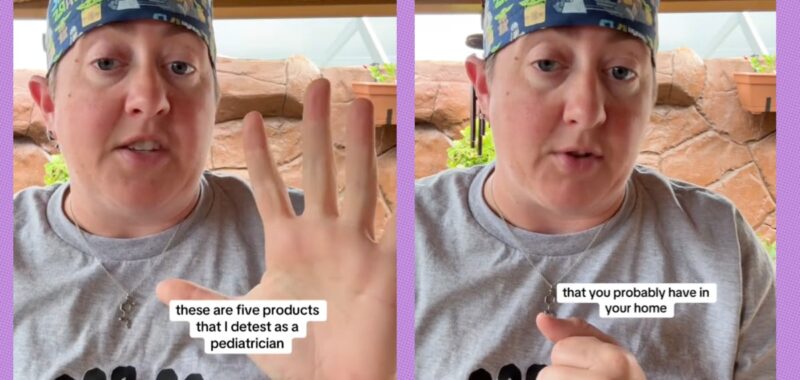Having a sick child is difficult and often scary. You don’t always know what to do to make them feel better, and it’s made all the worse when they’re too little to tell you what’s wrong.
But as cold and flu season approaches, Meghan Martin, a pediatric emergency medicine doctor, mom of four, and TikTok creator who posts as @beachgem10, warns parents against five products she “despises” as a pediatrician.
Cough & cold medicines meant for children under 6
“These are not recommended, they are expensive, and they generally do nothing, and they have a lot of side effects associated with them,” she begins.
Instead, she suggests ditching the pricy placebos with Ibuprofen and Tylenol for fever and discomfort; fluids with electrolytes (like Gatorade); saline nasal sprays; and cool mist humidifiers.
Neosporin
This one got us too: we had no idea this was “problematic.” But Martin says that this commonly causes hypersensitivity reactions on the skin. Instead, she suggests washing the cut with soap and water and following with use of Vaseline, Aquaphor, or Bacitracin. Like Neosporin, Bacitracin is an antibiotic ointment. While both are effective and generally well tolerated, Bacitracin is a brand-name drug with one active ingredient: bacitracin.
Neosporin is a combination ointment made with the active ingredients bacitracin, neomycin, and polymyxin b, and the latter is associated with greater instances of allergic reaction or sensitivity.
Fragrance for babies
Not, like a perfume — though Eau de Bébé would probably small great — but “soaps, lotions, and detergents meant for infants and newborns that have fragrance.”
“So many of these kiddos end up with contact dermatitis or worsening eczema symptoms,” she explains.
In this case, Martin recommends no one-for-one alternative: just get rid of anything with fragrance for your wee one.
Toddler formulas
“There’s absolutely a group of kids that medically needs this food,” she explains. Her issue comes down to products like this marketed to children who do not… and most kids just don’t. This is a claim backed by the American Academy of Pediatrics.
“Toddler formulas are expensive,” she enumerates. “They’re teaching kids to drink their calories rather than eat their nutrition, and there’s just no indication for them.”
Gummy vitamins
We know. We know. But hear her out because… yeah, this one makes a lot of sense.
“These are literally candies that have vitamins sprayed over the top of them,” she says. “Because of that the doses are inconsistent or completely inaccurate.”
This claim is often but not always true, per reporting from Time. Some gummy vitamins have the vitamins sprayed on. But this fact in and of itself points to a larger problem with gummy vitamins — this is done in an attempt to combat the reality that no matter how you make them, it’s very difficult to get exact dosages in each gummy.
But the issues with these products don’t end there. Gummies get stuck on teeth and put children at a higher risk of cavities.
Also, according to Martin, most kids don’t even need vitamins; they get the nutrition they need from food, which is very often fortified with vitamins already.
If you’ve used this in the past, or are using them now, don’t feel bad, but do think twice.
“These products have tremendous marketing departments,” Martin says. Instead, if you have a question it’s better to call up your child’s doctor to see what they recommend. Incidentally, the good doctor herself has some tried and true recommendations she suggests in another video to help you prepare for this very germy time of year.

